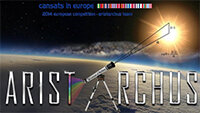Meet the team: Aristarchus
| Teacher: | George Kontellis |
| Team members: | Manolis Protoulis (Team leader, Programming, Spectroscope), Othonas Kontos (Programming, solar camera), Katzanis Panagiotis (Hardware, Electronics), Marilena Bougoulia (Design, Parachute, Electronics, Hardware), Michaela Papachiou (Hardware, Structure, Parachute), Aivaliotellis Giannis (Hardware, Electronics), Dimitris Spatharis (Design, Electronics, Outreach), Anthony Myrsinias (Programming, Spectroscope), Nearchos Prokopiou (Hardware, Solar tracker, team design) |
| School: | 3rd Lyceum of Mytilene |
| Country: | Greece |

Description of the Cansat missions
Aristarchus CanSat will track the sun, lock on it, and carry out various experiments.
Progress Report 1:
Aristarchus CanSat will track the sun, lock on it, and carry out various experiments. So we design and assemble a solar-tracker, a Spectroscope and we will attach a camera. All the Aristarchus’s systems (microcontroller, Pressure and Temperature Sensors, GPS, Transceivers, Solar Tracker) are working and tested in the school lab using the Arduino Mega and Uno Microcontrollers and now we are focused in implementing them into the Can using the T-Minus Microcontroller which gives us better volume control. We concluded in the Parachute and the cover shape and dimensions and we started creating them.
Progress Report 2:
Aristarchus CanSat will track the sun, lock on it, and carry out various experiments. So we design and assemble a solar-tracker, a Spectroscope and we will attach two cameras.
All of Aristarchus’s systems (microcontroller, Pressure and Temperature Sensors, GPS, Transceivers, Solar Tracker) are working and tested in the school lab using the Arduino Mega and Uno Microcontrollers and the T minus. After lots of experiments we decided to use two separate Nano Microcontrollers, one for the primary mission and the GPS and one for the solar tracker, which gives us better space control.
We decided on the parachute and the cover shape and dimensions and we started creating and testing them. The outer shell and the inside levels will be made of carbon fibres to reduce weight and make the construction more durable. A special resin will be used to reinforce the fibres and protect the CanSat during the fall.
Progress Report 3:
Aristarchus CanSat tracks the sun, locks on it, and carries out various experiments. So we design and assemble a solar-tracker, a Spectroscope and attached a camera. All the Aristarchus’s systems (microcontroller, Pressure and Temperature Sensors, GPS, Transceivers, Solar Tracker) are working and tested in the school lab using an Arduino Nano Microcontroller. We made a last-moment decision to use 3D printing to construct our CanSat because it was necessary to achieve an extremely detailed design and carbon fiber wouldn’t do the job for us. Carbon fiber will be used only at the top of our CanSat.
Visit the team's Facebook page.

